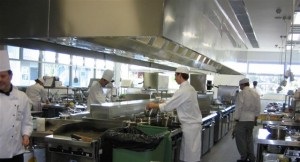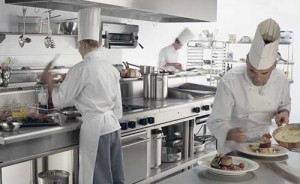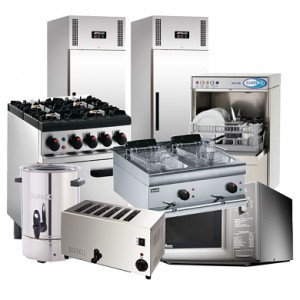THE KITCHEN
The kitchen itself is almost a separate kingdom within the hotel. The head cook,almost designated by the French word chef, is the boss of this hot, steamy, and at times chaotic area. The chef is responsible for planning the menus that is, the food that is being served on a particular day and for supervising the work of the other chefs and cooks. In very large or elaborate setups, the head cook is called the executive chef, and his responsibilities are largely those of a manager. He plans, purchases, and frequently coordinates the operation of several restaurants.
Depending on the size of the establishment, several assistant chefs report to the chef.These include a sauce chef, a salad chef, a vegetable chef, and so on. Under the chefs are the cooks who actually cook the food and then place it on the plate for the waiters to pick up.
Under the cooks? supervision are the kitchen helpers who, for example, peel potatoes, cut up vegetables, and bring food from the storeroom to the kitchen. The kitchen staff also includes dishwashers, even in a kitchen equipped with electrical appliances, since pots and pans usually need special attention, and someone must load and unloaded the machines.
In the restaurant, as well as in the kitchen, there are also different kinds of jobs. The person who seats the guests is called a captain or maitre d? (short for maitre d?hotel, another French expression that keeps appearing in the hotel and restaurant business), or a hostess, if a woman. In restaurants with a very formal style of service, the captain also takes the guests?
orders. The meals are served by waiters or waitresses. In less formal restaurants, the waiters and waitresses take orders and serve the meals.
Tıtles Used In The Kıtchen
1- Executive Chef or Head Chef
2- Assistant Chef or Second Chef
3- Sous Chefs
a. Larder Chef
b. Pastry Chef
c. Vegetable Chef
d. Butcher
4- Section Heads
a. Sauce Cook
b. Soup Cook
c. Vegetable Cook
d. Grill Cook
e. Roast Cook
f. Fish Cook
g. Breakfast Cook
h. Night Cook
i. Staff Cook
Other positions:
j. Relief Cook
k. Aboyeur or Caller
l. Commis (Apprentice) Cook
m. Kitchen Clerk
n. Pantryman
o. Potwash
p. Kitchen Porter
q. Steward
1.2.Kıtchen Equıpment
1.2.1.Large Equıpment
Large equipment can be divided into three distinct sections:
Un-powered Powered mechanical Powered static
Tables floor-standing mixers cooker
Benches liquidizers refrigerator
Sinks potato/vegetable peeler steamer
racks table mixers salamander
chip cutter grill
oven spit bain-marie
freezer
deep fryer
bratt pan
jacket boiler
griddle
microwave
CLEANING OF LARGE EQUIPMENT
a) GRILL OR SALAMANDER
1-Turn off heat supply. Allow to cool.
2-Scrape and scrub bars, racks and trays to remove all food particles and gease.
3-Empty grease trap.
4-De-grease outside areas and wipe clean.
Frequency: Dependent upon use. Do not allow grease or food particles to build up. Ideally clean after each session.
b) DEEP FRYER
1-Turn off heat supply. Allow to cool.
2-Filter oil out to remove food particles.
3-Wash inside with hot, soapy water to remove all grease.
4-De-grease outside areas and wipe clean.
5-Re-fill with clean oil.
Frequency: Dependent upon use. When oil looks dirty, has sour odor, tend to froth,
and looks dark. Ideally clean after each session if possible.
c) REFRIGERATOR
1-Turn off power supply and remove all contents to another cold place.
2-If not self-defrosting, prop open the door and place drip trays on shelves.
3-Hot wash all shelves and crisper. Dry well.
4-Wipe all inside walls and flor of cabinet using odourless cleaning agent/sanitizer or
washing soda in water. Remove all traces of food.
5-Replace all shelves and turn on power.
6-Wash all areas of exterior especially the handle area. Wipe with sanitizer.
7-When cooled to correct temperature, replace the food.
Frequency: Check content rotation every day. Clean frequently. Defrost once a month.
d) REFRIGERATOR(WALK-IN)
1-Leave power on. Work as quickly as possible. Remove all
contents to a cold place.
2-Prop door open.
3-Hot wash all shelves. Wipe with sanitizer.
4-Wash flor. Rinse and wipe dry.
5-Close door and wait for temperature to return to normal.
6-Replace food.
Frequency: As for smaller refrigerator.
e) ELECTRIC MIXER(FLOOR STANDING)
1- Disconnect power.
2- Take off bowl and attachment to hot wash. Rinse and dry.
3- Wipe down machine with hot soapy cloth to remove all food particles.
4- Rinse and wipe dry.
5- Replace bowl. Keep attachments close by in closed container.
6- Cover machine if not in use for long periods.
Frequency: After each use or daily.
f) BAIN-MARIE
1-Turn off heat supply. Allow to cool.
2-Remove all foods. Hot wash containers ready for use.
3-Let water out carefully. Discard.
4-Wash inside and out, wipe dry.
5-Leave doors open for ventilation.
Frequency: After each session.
1.2.2.Small Equıpment
Food Cutters : Food Cutter is a machine which can cut, dice, and shred meats,vegetables, and fruits.Food is placed in a bowl that rotates and exposes the food to high-speed rotating blades. Food cutters and
choppers should be rinced after each use.
Slicer : The essential elements of a food slicer are a circular knife blade and a carriage that passes under the blade. These allow for strict control of the thickness of slices of food.
Mixer : A mixer is a machine used for mixing things together.A mixer can do much more than mix food. Adapters are available to allow chopping, dicing, shredding, and juice extraction. Mixers should be cleaned after use.
Vegetable Peelers : You can peel a great amount of vegetable by using this machine.
Rules in caring for small equipment
· Always check equipment is clean before use.
· Scrape food particles away with plastic scraper.
· Rinse with jet of water if available.
· Wash or soak in hot soapy water.
· Scrub to remove stubborn stains and persistent food deposits.
· Rinse in very hot water or use a sterilizing product.
· Ideally, dry in hot atmosphere. Or dry with clean tea towel.
· Lightly oil rust-prone trays.
· Lightly bleach polyethlene to remove stains and bacteria.
· Use lemon juice or vinegar with salt to remove discolouration from copper.
· Do not plunge hot pans or trays into cold water as this will cause wrap.
· Report faulty equipment promptly.
· Store utensils in a warm dry place, on neat racks or in cupboards.
Dry-Heat equipment
· Rangers : Rangers, either gas or electric, are the most basic piece of cooking equipment for most food service operations.It is important that grease traps be easily removable for both cleaning and maintenance.
· Conventional Ovens: Because conventional ovens are used a great deal, durability is important.
· Convection Ovens : Convection ovens require less labor, space, and energy, cook at lower temperatures.
· Infrared Ovens : They cook at high temperatures for relatively short periods.
· Mechanical and Pizza Ovens: The major differences between conventional and mechanical ovens are that the latter are larger and have mechanical parts inside that help move the food while inside the oven. Pizza ovens are deeper than the other types and allow for the horizontal placement of pizzas.
· Microvave Ovens : Microvave ovens use radiation to cook food.
· Deck Ovens : Deck ovens are decked or stacked to save on flor space.They may be either roasting or baking ovens.
· Broilers (griller) : You can cook the meat on a grid, which allows the fat to drip down. Broiler grates other movable parts should be cleaned daily.
· Deep ?Fryers : You fry the food in a large amount of fat or oil in deep-fryers.
Fryers should be cleaned daily or at least twice weekly, depending on use. Fat should be strained daily.
Dishwasher
A dishwasher is an electrically operated machine that washes and dries plates, saucepans, cutlery, etc. Dishwashers must be cleaned periodically using a detergent solution, rinsed
and dried.
Refrigeratior
A refrigerator is a large container which is kept cool inside, usually by electricity, so that food and drink which you keep in it stays fresh. The inside of reach-in refrigerators should be cleaned once a week.
1.3. Sanıtatıon and Food Safety
1.3.1. Major Sanıtatıon Problems
Foodborne Illnesses
Food borne illnesses occur because of:
Ø Inadequate cooling and cold holding. Storing food in large containers means that the food in the center of the container will not cool fast enough to prevent bacterial growth.
Ø Preparing food ahead of planned service. Food should not be prepared more than a day ahead of time.
Ø Inadequate hot holding. Contaminated food will come from holding food temperatures between 120 and 70 °F for not more than 4 hours.
Ø Poor personel hygiene/ infected persons. Inadequate handwashing and food contact with emplyees who have infectious diseases are major problems in this area.
Ø Inadequate reheating. It is important that temperatures be brought to 165°F and kept there for a time sufficient to kill any microorganisms.
Ø Cross-contamination. Cross contamination can come from such things as touching raw foods, then handling cooked foods before washing hands, inadequate cleaning of raw food items.
Ø Inadequate cleaning of equipment. It is especially important to sanitize sinks and cutting boards,ensure that water temperature is above the safe level, and that sanitizing agents are strong enough to reduce bacteria.
Ø Inadequate cooking or heat processing. Undercooking of poultry, pork, and eggs can cause that kind of problems.
Foodborne ilnesses occur from one of three sources: biological, chemical, and phsical.
Biological Sources
Bacteria. Biological contamination can come from bacteria, viruses, and parasites. Bacteria are transmitted by wind, moisture, dust, and direct contact with other living things. Bacteria prefer high-protein food products such as poultry, meat, gravy,eggs, salads, fish, and so on.
Bacteria can be destroyed by heat over 80°C, which is why it is so important to reheat cooked food or cook chilled meals thoroughly. It can be dry heat (baking, grilling, roasting, frying) or moist heat (boiling, poaching, stewing, braising, micro waving). Bacteria on surfaces, utensils or skin, can be destroyed with sanitizer or anti-bacterial soap.
Viruses. Viruses are spread to food by employees infected with the virus. This can occur through such means as failing to wash hands after going to the bathroom, coughing, sneezing, or wiping a runny nose with a hand. Hepatitis A is one common illness transmitted
by a virus. The most likely foods to cause illness through vital transfer are those which are
not heated after handling: salads, cold sandwiches, raw or uncooked oysters, and so on.Parasites. Parasites live within or feed off another organism. Parasites with their eggs can be contained in such foods as pork and fish. Parasites can be destroyed by cooking the food to a high enough level.
Chemical Contamination
Chemical contamination occurs when substances such as cleaning compounds or pesticides get into food. Those used in the manufacture of some cleaning agents can be harmful. It is necessary to select safe cleaning agents for use in food areas and to follow the manufacturer?s instructions at all times.
Physical Contamination
Physical contamination occurs when hair, dirt, and similar items come into contact with food.
Metals
Copper, zinc, tin and lead can all cause food contamination if they are allowed to come into contact with the food. Poor quality equipment and utensils should not be used.
Human Carriers
Some people unknowingly carry harmful bacteria within their bodies. They display no symptoms themselves, but can pass the bacteria on to others through the food chain. It is for this reason that these carriers must not be allowed to work in the food industry.
Food Poisining
Food poisoning is caused by eating food that looks normal but is in fact contaminated with harmful bacteria. The symptoms are sickness, diarrhea and abdominal pains, and can develop from as soon as one hour after eating the food and up to thirty-six hours later. The illness must be treated by a doctor and can last for up to ten days. Some patients have to be hospitalized and in rare cases the poisoning can be fatal. The elderly and the young are more
likely to be dangerously affected than healthy adults.
1.3.2. Hıgh Rısk Foods
Some foods are more liable to bacterial growth and/or contamination than others. This is because they provide the ideal growing conditions for the bacteria. These high-risk foods are often high in protein and are not going to be re-heated prior to consumption.
For example:
· Cooked meats /sliced meats, pork pies, pasties, scotch eggs, sausage rolls, pate)
· Cooked poultry (cooked chicken portions, sliced chicken, pate)
· Cooked fish (smoked fish, fish paste and fish mousse)
· Eggs (fresh mayonnaise, egg custords, savory flans)
· Cooked cereals (rice, rice salads and pasta salads)
· Soft cheeses (those ripened with micro-organisms and moulds)
· Milk products (sauces, sweet desserts, trifles)
· Salads (pre-washed leaves, fruit and cereal-based)
· Sandwiches (protein-filled, salad-filled)
· Cream products (synthetic and fresh cream items)
1.3.3. Preparıng And Servıng Sanıtatıon Tıps
There are three important concerns about contamination: employee hygiene, time and temperature control, and the cleaning and sanitizing of utensils, equipment, and surfaces with which food comes into contact.
The following minimum temperatures are recommended in cooking:
45°F or below steak tartare
130°F beef
145°F potentially hazardous foods
150°F pork and pork products
155°F ground beef
165°F poultry and meat containing stuffing
165°F all foods previously served and cooled that are reheated
170°F pork and pork products cooked in a microwave
Holding equipment should never be used to heat food.
Milk, egg, and egg products should be stored at temperatures below 45°F. After
cooking, eggs should be held at a minimum of 140°F.Ice should be treated and handled with the same care as for food. Using hands, cups, or glasses to handle ice is to be avoided; hands carry germs, and glasses can break in the ice bin.
BAR SANITATION TIPS
· Wash glasses in a high-temperature dishwasher with a chemical sanitizer.
· Air-dry all glasses.
· Store glasses upside down.
· Store bar utensils such that they will be picked up by their handles.
· Use different cloths for wiping down bottles and wiping down the bar.
PERSONNEL HYGIENE
· Bathing daily with soap and water.
· Covering one?s mouth when caughing or sneezing, then washing hands immediately afterward.
· Avoiding such things as scratching the head or touching the mouth or nose.
· Not eating, drinking, chewing gum, or smoking when food is being prepared or cleaned.
· Avoiding the dropping of sweat onto Food or equipment.
· Using disposable towels to wipe away sweat and washing the hands before working with food.
· Keeping nails short and clean.
· Hand washing. Bacterial contamination occurs primarily when microorganisms are spread
to food from the hands of employees. For this reason, the best way to prevent contamination is effective hand washing. Hand sinks should be readily accessible and be used exclusively for this purpose.
Warm water, soap, and disposable towels or an airdrying machine are required for effective hand washing. Hands must be washed after any act that might cause contamination?using the toilet, eating or drinking, handling raw food, and so on.
· Clothing. Employee changing rooms should be kept seperate from food preparation areas. Uniforms should also be clean and changed when necessary to prevent contamination.
· Using Hat and Hair net in the Cooking areas to protect to food and prevent to
contamination.
KAYNAK
MEB MEGEP YIYECEK ICECEK HIZMETLERI MESLEKI INGILIZCE 1 ANKARA 2007
- Genel
- Yorumlar(0)



